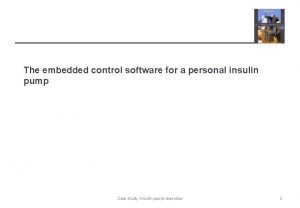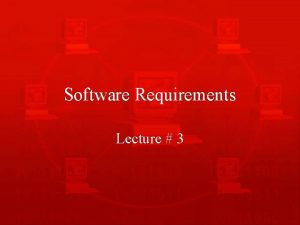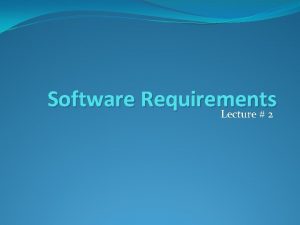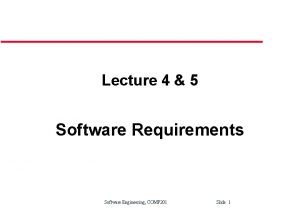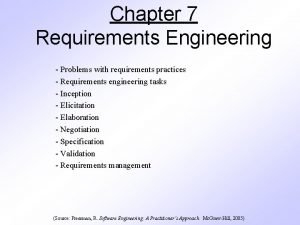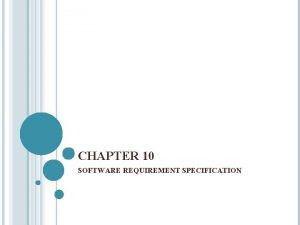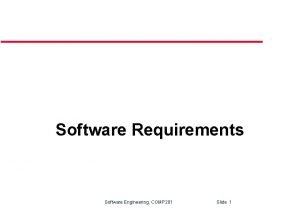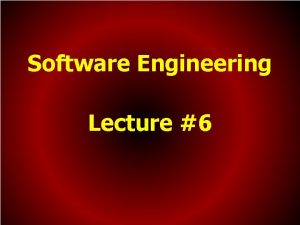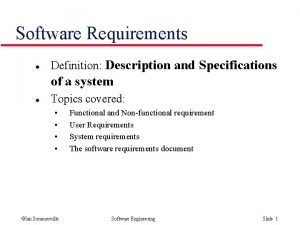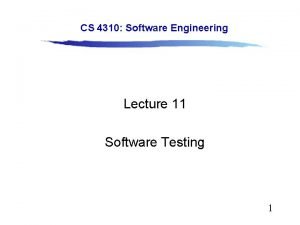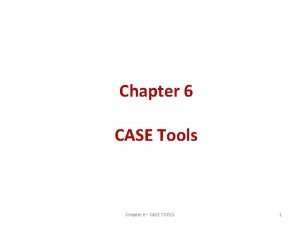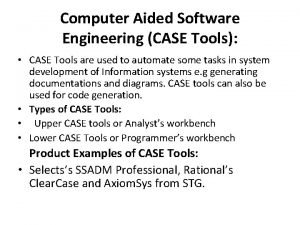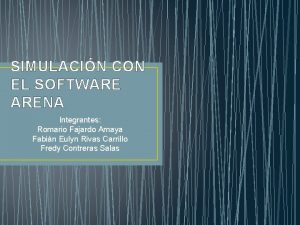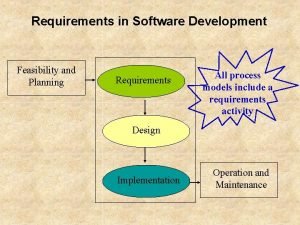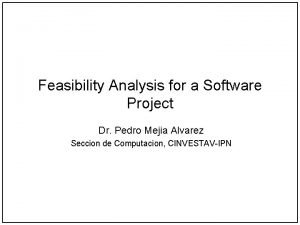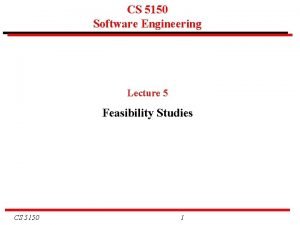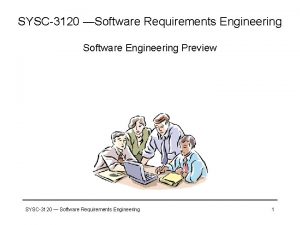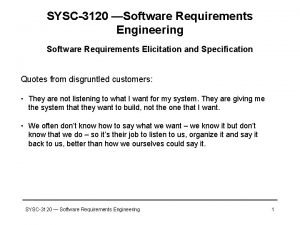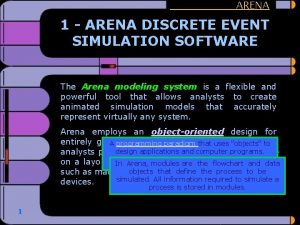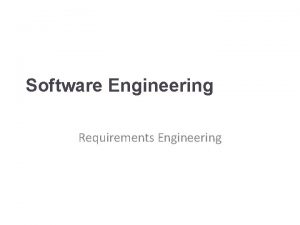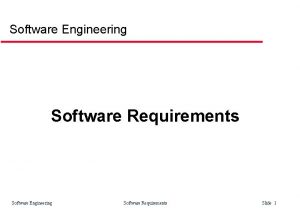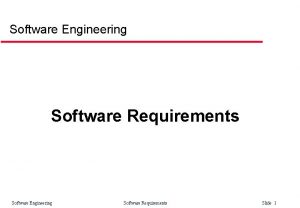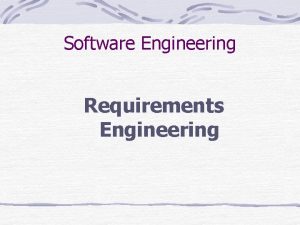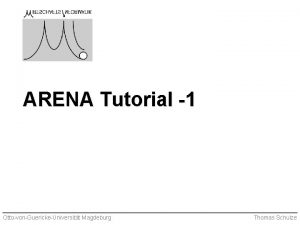SYSC3120 Software Requirements Engineering ARENA Case Study SYSC3120






























- Slides: 30

SYSC-3120 —Software Requirements Engineering ARENA Case Study SYSC-3120 — Software Requirements Engineering 1

ARENA Case Study • • Problem statement Requirement elicitation Use case model OO Analysis Model SYSC-3120 — Software Requirements Engineering 2

Initial Problem Statement 1. Problem • The popularity of the Internet and the WWW has enabled the creation of a variety of virtual communities: – groups of people sharing common interests – who have never met each other in person – can be short lived (e. g. , a group of people meeting in a chat room or playing a tournament) or long lived (e. g. , subscribers to a mailing list). • Many multi-player computer games now include support for the virtual communities of players: – – – receive news about game upgrades new game maps and characters announce and organize matches compare scores and exchange tips the game company takes advantage of this infrastructure to generate revenue or to advertise its products. SYSC-3120 — Software Requirements Engineering 3

Initial Problem Statement (2) Problem (cont. ) • Currently, however, each game company develops such community support in each individual game. • Each company uses a different infrastructure, different concepts, and provides different levels of support. • This redundancy and inconsistency results in disadvantages: – – learning curve for players when joining each new community, game companies need to develop the support from scratch advertisers need to contact each individual community separately this solution does not provide much opportunity for cross-fertilization among different communities. SYSC-3120 — Software Requirements Engineering 4

Initial Problem Statement (3) 2. Objectives • provide an infrastructure for operating an arena, including registering new games and players, • organizing tournaments, and keeping track of the players scores • provide a framework for league owners to customize the number and sequence of matches and the accumulation of expert rating points. • provide a framework for game developers for developing new games, or for adapting existing games into the ARENA framework. • provide an infrastructure for advertisers. SYSC-3120 — Software Requirements Engineering 5

Initial Problem Statement (4) 3. Functional requirements ARENA supports five types of users: • The operator should be able to define new games, new tournament styles (e. g. , knock-out tournaments, championships, best of series), define new expert rating formulas, and manage users. • League owners should be able to define a new league, organize and announce new tournaments within a league, conduct a tournament, and declare a winner. • Players should be able to register in an arena, apply for a league, play the matches that are assigned to the player, or drop out of the tournament. • Spectators should be able to monitor any match in progress and check scores and statistics of past matches and players. Spectators do not need to register in an arena. • The advertiser should be able to upload new advertisements, select an advertisement scheme (e. g. , tournament sponsor, league sponsor), check balance due, and cancel advertisements. SYSC-3120 — Software Requirements Engineering 6

Initial Problem Statement (5) 4. Non-functional requirements • Low operating cost. The operator must be able to install and administer an arena without purchasing additional software components and without the help of a full-time system administrator. • Extensibility. The operator must be able to add new games, new tournament styles, and new expert rating formulas. Such additions may require the system to be temporarily shut down and new modules (e. g. , Java classes) to be added to the system. However, no modifications of the existing system should be required. • Scalability. The system must support the kick-off of many parallel tournaments (e. g. , 10), each involving up to 64 players and several hundreds of simultaneous spectators. • Low-bandwidth network. Players should be able to play matches via a 56 K analog modem or faster. SYSC-3120 — Software Requirements Engineering 7

Initial Problem Statement (6) 5. Target environment • All users should be able to access any arena with a web browser supporting cookies, Javascript, and Java applets. • Administration functions (e. g. , adding new games, tournament styles, and users) used by the operator should not be available through the web. • ARENA should run on any Unix operating system (e. g. , Mac. OS X, Linux, Solaris). SYSC-3120 — Software Requirements Engineering 8

Identifying Actors and high-level Use Cases • Five actors are identified from the problem statement: – Operator, League. Owner, Player, Spectator, and Advertiser • High level use cases identified by looking at a narrow vertical slice of the system: Tic. Tac. Toe. Tournament (described in text and use-case diagram) 9

Glossary – define problem domain concepts SYSC-3120 — Software Requirements Engineering 10

Refine high-level Use Cases SYSC-3120 — Software Requirements Engineering 11

Brief description of Use Cases (1) SYSC-3120 — Software Requirements Engineering 12

Brief description of Use Cases (2) SYSC-3120 — Software Requirements Engineering 13

High-level use case Organize. Tournament SYSC-3120 — Software Requirements Engineering 14

Refine Organize. Tournament SYSC-3120 — Software Requirements Engineering 15

Exceptions occurring in Announce. Tournament SYSC-3120 — Software Requirements Engineering 16

Non-functional requirements (1) SYSC-3120 — Software Requirements Engineering 17

Non-functional requirements (2) SYSC-3120 — Software Requirements Engineering 18

Lessons Learned during Requirements Elicitation • Requirements elicitation involves constant switching between perspectives – high-level vs. detailed, – client vs. developer, – activity vs. entity. • Requirements elicitation requires a substantial involvement from the client. • Developers should not assume that they know what the client wants. • Eliciting non-functional requirements forces stakeholders to make and document trade-offs. SYSC-3120 — Software Requirements Engineering 19

OO Analysis Phase Develop the part of the analysis object model relevant to the Announce. Tournament use case of ARENA. • Start by identifying entity objects using Abbott’s heuristics • Identify boundary and control objects • Use sequence diagrams to find: – additional associations – objects – attributes. • Finally, consolidate the object model and represented it in a series of class diagrams. SYSC-3120 — Software Requirements Engineering 20

Entity objects (using Abbott’s heuristics) SYSC-3120 — Software Requirements Engineering 21 continue…

Entity objects (cont) SYSC-3120 — Software Requirements Engineering 22

Boundary Objects in Announce Tournament SYSC-3120 — Software Requirements Engineering 23

Object interaction: tournament creation workflow SYSC-3120 — Software Requirements Engineering 24

Object interaction: sponsorship workflow SYSC-3120 — Software Requirements Engineering 25

Object interaction: interest group workflow SYSC-3120 — Software Requirements Engineering 26

Consolidated class diagram: entity objects SYSC-3120 — Software Requirements Engineering 27

Inheritance hierarchy among entity objects SYSC-3120 — Software Requirements Engineering 28

Associations among boundary, control and selected entity objects SYSC-3120 — Software Requirements Engineering 29

Lessons learned during OO Analysis • Identifying objects, their attributes and associations, takes many iterations, often with the client. • Object identification uses many sources, including the problem statement, use case model, the glossary, and the event flows of the use cases. • A nontrivial use can require many sequence diagrams and several class diagrams. • It is unrealistic to represent all discovered objects in a single diagram. Instead, each diagram serves a specific purpose: – depicting associations among entity objects – depicting associations among participating objects in one use case. • Key deliverables, such as the glossary, should be kept up to date as the analysis model is refined. – others, such as sequence diagrams, can be redone later if necessary. – maintaining consistency at all times, however, is unrealistic. • There are many different ways to model the same application domain or the same system, based on the personal style and experience of the analyst. – This calls for developing style guides and conventions within a project. SYSC-3120 — Software Requirements Engineering 30
 Insulin pump case study in software engineering
Insulin pump case study in software engineering Inverse requirements
Inverse requirements Inverse requirements example
Inverse requirements example System requirements document
System requirements document Requirements discovery techniques in software engineering
Requirements discovery techniques in software engineering Domain requirements in software engineering
Domain requirements in software engineering What is domain requirements
What is domain requirements Comp requirements
Comp requirements Seven distinct tasks to requirements engineering
Seven distinct tasks to requirements engineering What are the characteristics of srs in software engineering
What are the characteristics of srs in software engineering System requirements in software engineering
System requirements in software engineering Sources of requirements in software engineering
Sources of requirements in software engineering Software requirements definition
Software requirements definition Best worst and average case
Best worst and average case Case western reserve university case school of engineering
Case western reserve university case school of engineering Hershey's erp failure
Hershey's erp failure Reverse engineering case study
Reverse engineering case study Beach recycling soft engineering
Beach recycling soft engineering Include extend use case
Include extend use case Test case in software engineering
Test case in software engineering Types of case tools in software engineering
Types of case tools in software engineering Types of computer-aided software engineering
Types of computer-aided software engineering Simulador arena ventajas y desventajas
Simulador arena ventajas y desventajas System procurement process in software engineering
System procurement process in software engineering Forward engineering in software engineering
Forward engineering in software engineering Feasibility study software engineering
Feasibility study software engineering What is feasibility study in software engineering
What is feasibility study in software engineering Feasibility study in software engineering
Feasibility study in software engineering Software maintenance in software engineering ppt
Software maintenance in software engineering ppt Who invented software engineering
Who invented software engineering Metrics computer science
Metrics computer science
